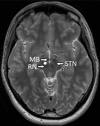Deep brain stimulation of the medial forebrain bundle for treatment-resistant depression - a narrative literature review
- PMID: 37082768
- PMCID: PMC9881632
- DOI: 10.5114/ppn.2021.110788
Deep brain stimulation of the medial forebrain bundle for treatment-resistant depression - a narrative literature review
Abstract
Purpose: Deep brain stimulation (DBS) is a relatively new and still experimental treatment modality for treatment-resistant depression (TRD). There is preliminary evidence that stimulation of brain reward circuit structures or their connecting white matter bundles may exert an antidepressant effect. The main nucleus of the reward circuit is the nucleus accumbens (NAc), which plays a critical role in reward-seeking behavior, motivation, and addiction. Also, white matter bundles connecting different structures of the reward circuit have been studied clinically as targets for DBS, including the medial forebrain bundle (MFB) - a central component of the mesolimbic dopaminergic reward circuit. This review aims to present the clinical outcomes of MFB DBS for TRD.
Views: The scientific literature was reviewed using the following keywords: 'DBS', 'major depressive disorders', 'TRD', and 'MFB'. The identified studies were assessed on the basis of patient characteristics, clinical outcomes, and adverse events related to DBS. The search revealed five open-label clinical case studies and four case reports reporting the cumulative number of 35 patients treated by MFB DBS for TRD.
Conclusions: The current clinical data of MFB DBS are limited by small sample size and the small number of clinical open-label trials. There is an urgent need for more clinical trials targeting the MFB for TRD. The results obtained in these studies showed a very rapid antidepressant effect observed within one week after the start of stimulation. MFB DBS for TRD should be considered as a last resort treatment due to its invasive character. However, this treatment may be a promising alternative for TRD patients.
Cel: Głęboka stymulacja mózgu (DBS) jest stosunkowo nową i wciąż eksperymentalną metodą leczenia lekoopornej depresji (TRD). Istnieją wstępne dowody na to, że stymulacja struktur układu nagrody lub łączących je pęczków istoty białej może wywierać działanie przeciwdepresyjne. Głównym jądrem układu nagrody jest jądro półleżące (NAc), które odgrywa kluczową rolę w zachowaniu związanym z poszukiwaniem nagrody, motywacji i uzależnieniach. Stymulacja NAc jest skuteczna w TRD poprzez zmniejszenie anhedonii i apatii. Nie tylko jądra, ale także pęczki istoty białej łączące różne struktury układu nagrody zostały przebadane klinicznie jako cele dla DBS, w tym przyśrodkowy pęczek kresomózgowia (MFB) – główny element mezolimbicznego dopaminergicznego układu nagrody. Celem pracy jest przedstawienie wyników klinicznych MFB DBS w leczeniu TRD.
Poglądy: Do przeglądu literatury naukowej użyto następujących słów kluczowych: „głęboka stymulacja mózgu”, „ciężkie zaburzenie depresyjne”, „lekooporna depresja”, „przyśrodkowy pęczek kresomózgowia”. Zidentyfikowane badania zostały ocenione na podstawie charakterystyki pacjentów, wyników klinicznych i zdarzeń niepożądanych związanych z DBS. Wyniki przeglądu literatury ujawniły pięć badań klinicznych i cztery opisy przypadków prezentujące łączną liczbę 35 pacjentów leczonych przez MFB DBS z powodu TRD.
Wnioski: Aktualne dane kliniczne dotyczące MFB DBS są ograniczone małą liczebnością badanych prezentowanych w kilku badaniach klinicznych. Istnieje pilna potrzeba przeprowadzenia większej liczby badań klinicznych dotyczących stymulacji MFB w leczeniu TRD. Wyniki uzyskane w tych badaniach wykazały bardzo szybkie działanie przeciwdepresyjne obserwowane w ciągu tygodnia od rozpoczęcia stymulacji. Z uwagi na inwazyjny charakter, MFB DBS należy traktować jako leczenie ostatniej szansy. Jednak leczenie to może być obiecującą alternatywą dla pacjentów cierpiących na TRD.
Keywords: deep brain stimulation; major depressive disorder; medial forebrain bundle; treatment-resistant depression.
Copyright © 2021 Institute of Psychiatry and Neurology.
Conflict of interest statement
Absent./Nie występuje.
Figures


Similar articles
-
The ventral capsule and ventral striatum-Stereotactic targets for the management of treatment-resistant depression. A systematic literature review.Front Psychiatry. 2023 Oct 20;14:1100609. doi: 10.3389/fpsyt.2023.1100609. eCollection 2023. Front Psychiatry. 2023. PMID: 37928918 Free PMC article.
-
The medial forebrain bundle as a deep brain stimulation target for treatment resistant depression: A review of published data.Prog Neuropsychopharmacol Biol Psychiatry. 2015 Apr 3;58:59-70. doi: 10.1016/j.pnpbp.2014.12.003. Epub 2014 Dec 19. Prog Neuropsychopharmacol Biol Psychiatry. 2015. PMID: 25530019 Review.
-
Medial Forebrain Bundle Deep Brain Stimulation has Symptom-specific Anti-depressant Effects in Rats and as Opposed to Ventromedial Prefrontal Cortex Stimulation Interacts With the Reward System.Brain Stimul. 2015 Jul-Aug;8(4):714-23. doi: 10.1016/j.brs.2015.02.009. Epub 2015 Feb 27. Brain Stimul. 2015. PMID: 25819024
-
Increased dopamine receptor expression and anti-depressant response following deep brain stimulation of the medial forebrain bundle.J Affect Disord. 2017 Aug 1;217:80-88. doi: 10.1016/j.jad.2017.03.074. Epub 2017 Apr 5. J Affect Disord. 2017. PMID: 28395208
-
Deep brain stimulation for treatment-resistant depression: an integrative review of preclinical and clinical findings and translational implications.Mol Psychiatry. 2018 May;23(5):1094-1112. doi: 10.1038/mp.2018.2. Epub 2018 Feb 27. Mol Psychiatry. 2018. PMID: 29483673 Review.
Cited by
-
Deep brain stimulation for the treatment of major depressive disorder: complex psychiatric aspects.Postep Psychiatr Neurol. 2022 Sep;31(3):141-142. doi: 10.5114/ppn.2022.121836. Epub 2022 Dec 5. Postep Psychiatr Neurol. 2022. PMID: 37082227 Free PMC article. No abstract available.
-
Mechanisms of nucleus accumbens deep brain stimulation in treating mental disorders.Fundam Res. 2024 Jul 6;5(1):48-54. doi: 10.1016/j.fmre.2024.06.009. eCollection 2025 Jan. Fundam Res. 2024. PMID: 40166085 Free PMC article. Review.
References
-
- Uher R, Payne JL, Pavlova B, Perlis RH. Major depressive disorder in DSM-5: implications for clinical practice and research of changes from DSM-IV. Depress Anxiety 2014; 31: 459-471. - PubMed
-
- WHO . Depression and Other Common Mental Disorders Global Health Estimates. Geneva: World Health Organization; 2017.
-
- Amital D, Fostick L, Silberman A, Beckman M, Spivak B. Serious life events among resistant and non-resistant MDD patients. J Affect Disord 2008; 110: 260-264. - PubMed
-
- Rush A. Acute and longer-term outcomes in depressed outpatients requiring one or several treatment steps: a STAR*D report. Am J Psychiatry 2006; 163: 1905. - PubMed
-
- Gaynes BN, Asher G, Gartlehner G, Hoffman V, Green J, Boland E, et al. . Definition of Treatment-Resistant Depression in the Medicare Population. Rockville: Agency for Healthcare Research and Quality; 2018. - PubMed
Publication types
LinkOut - more resources
Full Text Sources
